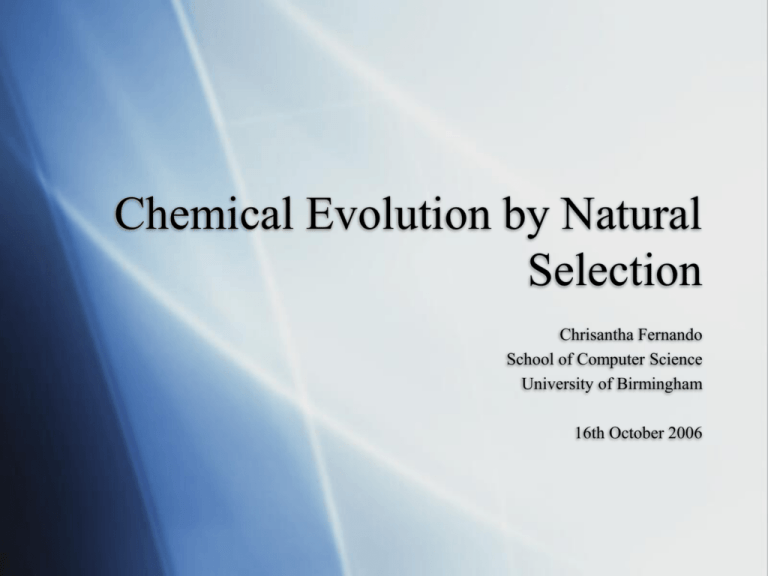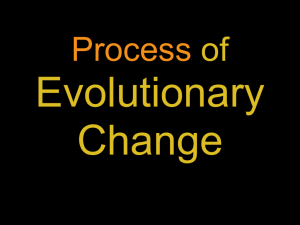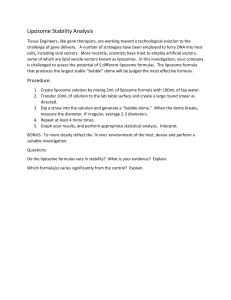Chemical Evolution by Natural Selection
advertisement

Chemical Evolution by Natural
Selection
Chrisantha Fernando
School of Computer Science
University of Birmingham
16th October 2006
My Claim
I claim that the spontaneous origin of a
geophysical natural selection machine was
necessary for the production of increasingly
ordered chemical organizations ultimately leading
to a nucleotide producing metabolism.
I reject other “self-organizing principles” that have
been proposed to explain the origin of metabolism.
How did unlimited heredity
arise?
Template replication of sequences allows
unlimited heredity, 4100 ~1060 messages.
If a new message was produced each second
for 4 billion years, we would still have only
~ 1038 of the 1060 possible messages.
How could template replication arise?
Ribonucleotides could not have
formed spontaneously.
Specific synthesis of ribose, specific
phosphorylating agents.
QuickTime™ and a
TIFF (Uncompressed) decompressor
are needed to see this picture.
The need for ‘Self-Organization’.
“Clearly, some complex chemistry must have
“self-organized” on the primitive earth and
facilitated the appearance of the RNA world.”
Leslie Orgel, (2000).
Graham Cairns-Smith: Clay Templates.
PNAs etc.. Eschenmoser.
Metabolic Self-Organization. I will discuss how
metabolic self-organization could arise through
natural selection.
Chemical Evolution
Miller’s non-random synthesis of formic
acid, alanine, glycine etc… eventually
resulted in tar; a combinatorial explosion of
polymers, but no increasingly ordered
chemical organizations.
QuickTime™ and a
TIFF (Uncompressed) decompressor
are needed to see this picture.
What modifications must be made to this protocol
to allow…
What do we want?
Open ended evolution (Bedau et al 2000)
Origin of basic autonomy, i.e. a dissipitive system capable of the
recursive generation of functional constraints (Ruiz-Mirazo, 2004).
Production of nucleotides (Maynard-Smith & Szathmary, 1995).
Coupled cycling of bioelements (Morowitz, 1968)
Maximization of entropy production by the biosphere (Kleidon, 2004)
The minimal unit of life: Membrane, Template Replication,
Metabolism. (Ganti, 2003)
Autopoetic units, (Membrane, Metabolism) (Maturana and Verala,
1992).
What is Metabolism?
The set of processes (e.g. chemical reactions)
producing the constituents of the ‘organism’.
An organism is a spatially distinct unit.
But some people try to define metabolism nonspatially, e.g. a closed and self-maintaining set of
chemicals and reactions (Dittrich and Spironi,
2005, Kauffman, Fontana, etc…).
But organismal metabolism is not closed, it is
externally recycled.
A spatially distinct individual necessary for
‘organismal metabolism’, the sort which interests
us.
Theories of Self-Organization of
Metabolism are Flawed.
Eigen’s idea and Kauffman’s model of Reflexive
autocatalytic sets of proteins.
Fontana’s idea of self-organization of higher order
chemical organizations in a flow reactor, modeled
with Lambda Calculus.
Morowitz’ idea (and recently Dewer’s arguments
for) a self-organizing force due to the existence of
a steady state energy flux.
Reflexive Autocatalytic Sets
Each member has its formation catalyzed by
one or more members of the set.
Kauffman Side-steps SideReactions
Kauffman’s
Universe
Our
Universe
The system is ‘spreading’
if the problem of poisoning
catalysis is not completely
ignored as Kauffman did.
Calculations of probabilities about such
systems always assume that a protein may or may not
catalyse a given legitimate reaction in the system but that
it would not catalyse harmful side reactions. This is
obviously an error. Hence the paradox of specificity
strikes again -- the feasibility of autocatalytic attractor
sets seems to require a large number of component types
(high n), whereas the plague of side reactions calls for
small systems (low n). (Eors Szathmary, 2000)
Kauffman Ignores Precursor
Depletion
Kauffman’s
Universe
If there is depletion then…
the precursors of the set
must be re-cycled!
In Kauffman’s universe
there is constant excess
of a vast diversity
of precursors.
Our
Universe
In our universe, we need to
assume more limited initial
recycling capability.
Conclusion on Kauffman
Kauffman has proposed an alternative selforganizing principle in addition to natural
selection, but it does not work if
We take side-reactions seriously.
We assume limited diversity of recyclable precursors.
No reflexive autocatalytic set has been produced.
We reject this as a relevant self-organizing
princple in the origin of life.
Fontana and Buss’ Lambda
Calculus.
They claim, “self-organization arises in a system lacking any
formulation of Darwinian selection”.
Flow reactor consisting of string re-writing expressions, no mass or
energy conservation, but chemical reactions are modeled as
equivalence classes of operations.
If self-copying is forbidden, larger (L1) organizations of string subsets
arise that are self-maintaining.
They claim NS could not happen, but it could since there could be > 1
L1 organization present.
String > a maximum length are forbidden, i.e. again the problem of a
combinatorial explosion producing tar is nicely forgotten.
In conclusion: We reject that any self-organizing principle other than
natural selection acts in Fontana’s reactor, and we reject that it would
work in real chemistry since the same problem of side-reactions is
ignored.
Energy Flow “Organizes a
System”.
Claims that life is driven by radiant energy to
attain complexity in the form of coupled cycling
of material.
Although careful to mention that “complexity
alone is an insufficient measure for characterizing
the transition from non-living to living”, he goes
on to claim that…
“Miller type experiments indicate the great
potential for a directed energy input to organize a
system.”, organization being defined as
compressible complexity.
The Logical Error.
QuickTime™ and a
TIFF (LZW) decompressor
are needed to see this picture.
The last statement does not follow from the first.
e.g.the continued steady state flux through a cloud or a
Bernard cell does not arise because the physical properties
of the system were ‘informationally’ specified (ordered)
by the energy flux itself.
Energy Flux not a ‘driving force’
for organization.
Only a small subset of systems driven by external
energy become increasingly organized, in others
the size of the sink increases, with loss of capacity
for recycling.
How does the subset of dissipative systems
increase their capacity for recycling and their rate
of entropy production?
I propose it is the subset capable of natural
selection that have this property. A steady-state
energy flux is necessary for the maintenance of the
initial natural selection machine.
Natural Selection
Algorithmic process occurring in populations of
entities having multiplication, heredity and
variation (JMS, 1986).
What is the simplest machine capable of
sustaining natural selection, that is likely to have
formed spontaneously?
The Oparin school first proposed natural selection
as a mechanism of prebiotic evolution, but with
little experimental success.
Alexander Oparin 1894-1980
Quic kTime™ and a
TIFF (Unc ompres sed) dec ompres sor
are needed to see this pic ture.
QuickTime™ and a
TIFF (Uncompressed) decompressor
are needed to see this picture.
Coacervates = spontaneously formed polypeptide structures.
He distinguished between artificial and natural coacervates.
He proposed variation in polypeptide composition.
No self-replication or heredity was demonstrated.
Fox & Dose, Folsome, Bahinder,
Weber
Fox and Dose: Polypeptide microspheres in which budding occurred
due to potentially non-random polycondensation reactions. Details of
heredity were not studied. (1977).
Folsome observed that the ‘thin oily scum’ on the surface of the water
in the Miller experiment formed exponentially growing
microstructures and then sank to the bottom of the flask (no continued
lineage). (1979)
Bahinder showed that formaldehyde, ammonium phosphate, mineral
salts and ammonium molybdate exposed to sunlight formed spherical
microstructured called “Jeewanu”.(1954).
Weber (2005) described a synthesis of microspherules from sugers and
ammonia without reference to Bahinder’s work.
But no-one has demonstrated natural selection in populations of
spontaneously formed phase separated individuals.
Chemical Evolution by Natural
Selection
The origin of metabolism occurred under the
following conditions.
A spontaneous natural selection machine arose capable
of…
Production of lipophilic material to replenish phase separated
individuals formed from that material.
A process of agitation to replicate a liposome
A reaping of liposomes to impose selective pressure.
The capacity for variation by ‘chemical avalanches’ within
liposomes.
Some novel chemicals produced in an avalanche can aid I.
liposome growth, ii. liposome division.
11
The artificial version for the lab.
(1) Basal Liposome Growth
No chemical reactions
a
Just phase separation
a
aa a
a
a
a
a
a
(2) Liposome Division
a a
a
aa a
a
a
a
a
a
a
a
a
a
(3) Chemical Avalanches?
QuickTime™ and a
TIFF (LZW) decompressor
are needed to see this picture.
QuickTime™ and a
TIFF (Uncompressed) decompressor
are needed to see this picture.
Pyrite
b
a
b
c+d
RARE (low flux) reaction
a
C happens to be autocatalytically produced, it need
not have been.
b
c+d
High flux
reaction
a
c+e
?
But now we
must calculate
the reactions of
e and so on.
This is the avalanche.
The model asks…
Is the production of increasingly ordered
metabolism possible when variation is by
chemical avalanches, most of which are harmful
or neutral?
What metabolic topology is evolved?
What thermodynamic organization of metabolism
is evolved?
What are the fundamental constraints for natural
selection to act in such a system?
The Algorithm
A hill-climbing algorithm is used to select for
liposomes that maximize their growth after a fixed
period.
Parental (liposome) fitness is assessed, a child is
produced that inherits half the parental material,
and has experienced an avalanche. If its fitness is
greater than the parent, it replaces the parent, else
a new offspring is produced and assessed.
Algorithm 1 An Overview
Requ ire: generation = 0. t = 0. Initialize reactor with food set and initial reactions. Assume initial fitness
of ΤvirginΥliposome = 0. Generation_time = 10,000 x 0.0001 seconds. Time-step = 0.0001 seconds.
1: for generation = 0 to Max_Gen do
2: Create offspring reactor by taking 50% of liposome phase material present at end of parental generation,
and replenishing the food set to its original concentration.
3: Generate Avalanche: Randomly (but a ccording to thermodynamic and m ass conservation constraints
described later) create novel rare reactions and the subsequent high f lux reaction avalanche. Initialize each
novel species at very low concentration (e.g. 10 -7mM).
4: Simulate Offspring: Using the novel reaction network and initial concentrations use Eular Integration to
simulate generation_time seconds of reaction dynami cs, measuring fitness at 1000 time-step intervals.
4.1: Simu late 3 offspring consecutive produced from the original offspring (with no chemical avalanches
between divisions), in order to ex clude non-inheritable avalanches. Calculate fitness only of the 3 rd
offspring.
5: if Offsprin g fitness > Parent fitness x 1.1 (i.e. offspring fitness must be at least 10% greater than parent)
6:
Replace Parental reactor with Offspring reactor.
7: end if
8: end for
The Artificial Chemistry
QuickTime™ and a
TIFF (LZW) decompressor
are needed to see this picture.
Energy
Each species is assigned a free energy of
formation, Gf.
Any novel reaction must be spontaneous,
G = Gproducts – Greactants < 0.
The equilibrium ratio of a reaction is given by K =
e-G/RT.
kb = 0.01 and kf = 0.01K
A species has an 80% chance of being lipophilic.
If a product is lipophilic, the reaction is effectively
irreversible.
Initial conditions
Food set. 100 mM: { aab, aaab, aabb, bbbb,
aaaab, aaabb, aabbb, abbbb. }
Gf= 1.0
Growth set. 0mM: : {abb (0.1), abbb (0.01),
abbbb (1), abbbbb (2), abbbbbb (3), abbbbbbb
(4), abbbbbbbb (5), abbbbbbbbb (5)}.
Algorithm 2: Ge nerate Avalanche
0: for N = 0 to num_low_propensity_reactions.
1: Choose two existing species (r1, r2) to r eact in a low pro pensity reaction (kf ~ 0, kb ~ 0) to produce two
potential products p1 and p2.
2: Generate the free energies of p1 and p2 (if they donΥtalready exi st) so that the follo wing relation holds,
Gp1 + Gp2 + he at = G r1 + Gr2 , by portioning energies according to a uniform random distribution, heat
being positive.
3: if it is not possible to satisfy this relation, e.g. because G p1 > Gr1 + G r2, then the reaction is not permitted,
and no new products are created.
4: else if the condition that the reaction is spontaneous can be satisfied, create novel products at low
concentration (e.g. 10 -7 M) and increment newSpec ++ //Store the number of novel species produced.
5: k f = k b = 0.
6: end if
7: end for
8: while newSpec != 1 do
9:
for i = 0 to newSpec
10:
for j = 0 to number of species currently existing
11:
if rand() < PROB_HIGH_FLU X x 1/(species[i].length)2
12:
*See tempNewSpecies = output of Algorithm 3
//Make high flux reaction with new species[i] and a random species
13:
//Store tempNewSpecies produced in that high flux reaction.
14:
end if
15:
16:
end for
end for
17: newS pec = tempNewS pecies, tempNe wSpecies = 0.
18: end while
Algorithm 3: Calculate a high flux reaction
1: Choose species to react with rare species i as follo ws.
2: for j = 0 to num species
3: score += 1/(length [j] Π length [i]) 2 x ( length [j]) 2
4: end for
5: U se roulette wheel selection to find species j biased by the above scores.
6: Once r1 = i and r2 have b een chosen, generate random p1 and p2 pro ducts based on a bimolecular
rearrangement of r1 and r2 . This reaction can be biased in va rious ways, e.g. let the probability of a
catalytic reaction, i.e. where r1 = p1, or r2 = p2, be rel ated linearly to the proportion of ΤbΥ atoms in r1 or
r2. etcΙ Many such structure specific probabilistic rules ma y be applied.
7: Check that Gp1 + Gp2 + h eat = G r1 + G r2 can be satisfied, and only if i t can, store this new high flux
reaction, and set kf = rand(C) x 0.01K, and
9: if p1 and p2 already exist, k b = 0 //C = 100 or 1000 and is a uniformly randomly
assigned rate. A log normal distribution has also been used Logrand(C).
10: else k b = rand(C) x 0.01.
//This is to ensure that the explor ation of the adjacent possible is correct
11: Return the number of new species produced legitimately, i.e. 0, 1 or 2.
Definition of Fitness
Fitness is defined as the integral over the trial of the product of [species[i]] x length of
Species i , where i is a molecule in the gr owth set. The second term introduces a biomass
effect. This is approxim ated by sampli ng concentrations at internals of 1000 tim e steps.
All trials are of fixed duration. The bolus of food molecules is all owed to deplete if the
chemical avalanche has produced species that react with the bolus, or if material has been
inherited that reacts with the bolus. This repli cates the effect of a potential mi crofluidic
experim ent in which a s ingle li posome is isolated in a small compartment containing a
bolus of food molecules, and its size measured after a fixed duration. In many of the
trials, fi tness is assessed not on the first offspring produced after a chemi cal avalanche,
but on the 3 rd post-avalanche offspring. This is to in crease the probabili ty that any fitness
benefit due to an avalanche is heritable, rather than beneficial only to the offspring in
which the avalanche occurs.
Results.
Agent I.D.
Num. S pecies
Num. Reactions
12648
61
47
20567
99
63
28807
122
76
33659
147
89
Energy dissipation increases
Avalanche properties change
over the course of evolution.
As molecule size increases the
chance of an autocatalytic
product from an avalanche
Decreases.
Mean Avalanche Properties
Conclusions
1.
2.
3.
4.
Liposome level selection maintains molecular replicators
arising in chemical avalanches.
Autocatalytic constituents are more likely to be short
molecules with few atom types (given random
rearrangement reactions).
An ecology of autocatalysts exists, non-competitive,
competitive, parasitic, cross-catalytic, but all selected on
the basis of by-product mutualism of autocatalysts
within the same liposome.
Lipophobic side products drive irreversible reactions,
whilst lipophilic non-reactive products prevent continued
drainage.
Conclusions
5.
6.
7.
A more diverse food set promotes more complex
autocatalytic cycles, 1,2, & 3 member cycles observed.
Energy flux increases over evolutionary time for two
reasons; energy demands of memory, energy demands of
growth.
Large generation numbers and large population sizes
will be necessary since most avalanches are harmful or
neutral, thus automated microfluidics is required,
perhaps under high pressure to promote chemical
avalanches.
Acknowledgements
Jon Rowe
Eors Szathmary
Hywel Williams
Kepa Ruiz-Mirazo
Fabio Mavelli
Alvero Moreno
Xabier Barandieran





